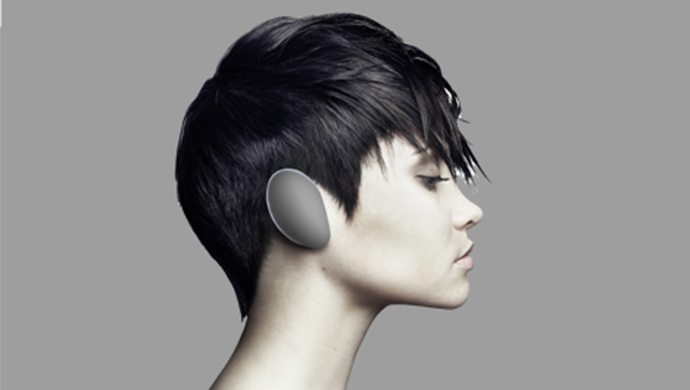“Sound” is designed to look and feel like a natural extension of the human body

US-based audio device startup Human Inc. has an ambitious goal: to deliver a “zen” portable listening experience; after all, the music can sometimes serve as a meditative medium.
So what is a zen design? Without sounding too pretentious, a zen-esque design, I believe, is one that embraces a minimalist philosophy.
But does that stance necessarily equate to form over function? Human Inc’s wireless earphones “Sound”, at first glance, certainly does not look very impressive. There are no wires, no buttons, and no labels on the outside. It is hard to compare it with anything, really, except for those ear prosthesis costume designers use to put on the aliens in Star Trek films.
But Sound is no prosthetic And it retails for a cool US$400 — a product clearly marketed towards audiophiles.
Design
Let’s first talk about Sound’s first key selling point: its natural and comfortable design. The ear cups are made out of silicone, and are designed to be flexible so that they can fit easily onto the user’s ears.
To ensure that the ear cups are a perfect fit, Human Inc is asking backers for its Kickstarter campaign to first use its Sizing app. Users then switch on the app and hold the phone close to their ears. After that, an algorithm in the ear-sizing system automatically calculates the optimal ear cup size.
Also Read: Why Muzik’s headphones may strike a chord with Singaporeans
Once that is done, Sound’s “Total-Encapsulating” should hug the back of the user’s ear completely, allowing for a snug fit.
In addition, its Mid-Ear System creates a sealant that improves the acoustic isolation of the earphones, allowing the user to hear the fine, nuanced guitar picking in “Tears in Heaven” even in a crowded shopping mall.
Human Inc. claims that the earphones are secure enough for the “most vigorous activity”, and are even comfortable to fall asleep with.
Functionality
As previously mentioned, Sound is devoid of any buttons. Instead, control is assigned to touch-swipe gestures. For example, to increase the volume, the user swipes upwards on ear cup; swipe right to skip a track; tap once to pause and tap twice to play a track.
Now there is no touch-swipe button to switch off the earphones. Instead, all users have to do is put both of Sound’s ear pieces together. It will then automatically enter into a low-power mode, and after a few minutes, switch itself off completely.
To switch it on again, pull apart the earphones and Sound will instantly switch on — indicated by a LED light — and connect to the last connected device via Bluetooth.
It’s all quite intuitive and certainly fits into the growing trend of virtual buttons. Less than a decade ago, iPhone sparked a revolution by killing off the physical keypad; the new iPhone 7 did away with the physical home button in favour of a taptic feedback pad. So the introduction of buttonless earphones should come as no surprise.
But wait, there is more!
For audiophiles, US$400 for a pair of comfortable earphones with good acoustics and intuitive controls may already be a justifiable price point.
But Human Inc. is also throwing a whole lot of bells and whistles to make your money’s worth.
First, it has implemented a social function. Users can look for other Sound users to share music with them via Sound’s “Human” app.
Also Read: This Aussie startup hit 180 times its crowdfund goal to make headphones that tune to your ear
Users can also activate an ambient noise cancelling feature for cut out obstructive environment sounds. On the flip side, users can also amp up external sounds with its embedded microphone (eavesdroppers, rejoice!).
The only caveat is Sound’s battery life, which lasts for a little over 12 hours. For comparison, my US$50 MEE audio Rumble AF80 wireless headphones lasts for 14 hours.
New features on the horizon
Sound has US$250,000 nearly on its Kickstarter campaign, more than 150 per cent of its initial goal.
But at this stage, it still exists as only a prototype.
Sure, Human Inc. could pat themselves on the back now and start clinking champagne glasses, but they are not done innovating.
Also Read: This smart home camera automatically shoots and edits the best moments in life
In fact, the team is still developing new — and rather ambitious — features for Sound.
These include a function to allow conversations to be automatically translated into another language in real time; a function to capture data for biometric monitoring; and enabling REM and noise-assist rhythms, as well as track sleep cycles.
In short, Sound is not built just to deliver aural pleasure; it is an IoT device that attends to all aspects of the user’s well-being and health.
—
Image Credit: Human Inc.
The post This US$400 earphones has no buttons, fits your ears naturally, and will help you sleep better appeared first on e27.